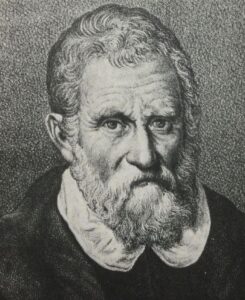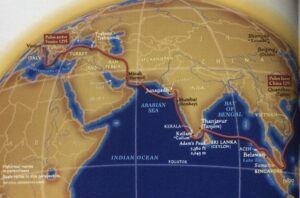by Sachi Sri Kantha, October 30, 2024
Prelude
Previously I had presented my view on Venician explorer Marco Polo’s (1254-1324) visit to medieval Eelam. [https://sangam.org/marco-polos-visit-to-medieval-eelam/]. This is a first sequel, to commemorate Marco Polo’s 700th death anniversary, which passed by on January 9th this year.
Where did Marco Polo and his party land in ‘Seilan’?
First I provide the final two short paragraphs from Richard Humble’s short biography of Marco Polo, published 50 years ago.
“Marco Polo was seventy years old when he died. Few if any men or women have ever seen as much as he did in his allotted ‘three score and ten’. Many famous men have had memorable dying words attributed to them, but those for which Marco is remembered have always been accepted – justly – as a perfect epitaph for him.
The story goes that his friends urged the dying man to take back some of the most obvious exaggerations he had made about his experience, lest he meet his Maker with lies on his conscience. To which Marco murmured: ‘I never told the half of what I saw…’ ”

Marco Polo (1254-1324), in his old age
Yes – if this story of that Marco had rebuked to his friendly inquisitors, with the words ‘I never told the half of what I saw…’, at his death-bed, certainly he had left numerous questions for pondering, as per his visit to the island ‘Seilan’. These are as follows:
- Where did his fleet of ships land in the island – was it the northern port of Point Pedro, or a southern port?
- Were the mariners who navigated his fleet of ships Chinese, or Malays or Tamils?
- For how long (months or weeks or days), did he stay on the island, before moving to Malabar region of India?
- Who were his native hosts (Tamils or Sinhalese)? In which language did he communicate with the natives?
- Were the natives fluent in any language (such as Chinese, Malayan, Arabic or Italian), other than their own?
The commonsense view is that Marco Polo and his party would have landed in the northern region of Jaffna. Check the National Geographic magazine’s (July 2001) map of Marco’s return route to Venice from China, provided nearby. However, an alternate view that Marco Polo’s sailboats probably touched a southern port (most probably, modern Galle) of the island also prevails. Prof. Don Patrick Mervyn Weerakkody (1945-2013) was a distinguished, vision-disabled scholar, affiliated to the University of Peradeniya. In his 1977 Ph.D. thesis, he recorded, “Marco Polo too calls the Sinhalese idolators, whereas he is particular to mention the existence of Christians in other eastern lands. [pp. 18-159]”
This fact about ‘Sinhalese’ is erroneous. Nowhere, in Marco Polo’s book, we find the natives being tagged ethnically as ‘Sinhalese’!
For reference, I provide below the complete text from Marco Polo, of the Yule-Cordier edition of 1920, WITHOUT the annotations by Henry Yule and Henry Cordier. Spellings are retained, as in the original. Only 469 words! Note, that the only individual named is ‘a king there whom they call Sendemain’ (in the 2nd paragraph). The 3rd paragraph also an unnamed ‘King of this island’. It is somewhat unclear whether the king Sendemain of the 2nd paragraph is the same one in the 3rd paragraph!
“Chapter XIV – Concerning the Island of Seilan
When you leave the Island of Angamanain and sail about a thousand miles in a direction of little south of west, you come to the Island of Seilan, which is in good sooth the best Island of its size in the world. You must know that it has a compass of 2400 miles, but in old times it was greater still, for it then had a circuit of about 3600 miles, as you find in the charts of the mariners of those seas. But the north wind there blows with such strength that it has caused the sea to submerge a large part of the Island; and that is the reason why it is not so big now as it used to be. For you must know that, on the side where the north wind strikes, the Island is very low and flat, insomuch that in approaching on board ship from the high seas you do not see the land till you are right upon it. Now I will tell you all about this Island.
They have a king there whom they call SENDEMAIN, and are tributary to nobody. The people are Idolaters, and go quite naked except that they cover the middle. They have no wheat, but have rice, and sesamum of which they make their oil. They live on flesh and milk, and have tree-wine such as I have told you of. And they have brazil-wood, much the best in the world.
Now I will quit these particulars, and tell you of the most precious article that exists in the world. You must know that rubies are found in this Island and in no other country in the world but this. They find there also sapphires and topazes and amethysts, and many other stones of price. And the King of this Island possesses a ruby which is the finest and biggest in the world; I will tell you what it is like. It is about a palm in length, and as thick as a man’s arm; to look at, it is the most resplendent object upon earth; it is quite free from flaw and as red as fire. Its value is so great that a price for it in money could hardly be named at all. You must know that the Great Kaan sent an embassy and begged the King as a favour greatly desired by him to sell him this ruby, offering to give for it the ransom of a city, or in fact what the King would. But the King replied that on no account whatever would he sell it, for it had come to him from his ancestors.
The people of Seilan are no soldiers, but poor cowardly creatures. And when they have no need of soldiers they get Saracen troops from foreign parts.”

Marco Polo’s return route, Nat Geographic, July 2001, p. 30
Now, I provide the annotation Note 3 (pp. 314-315) about King Sendemain, given by Yule and Cordier, first edition which appeared in 1871. Spellings and words in italics are retained, as in the original. The final two sentences of this annotation (149 words) deserve notice, for the clue of where Marco Polo landed in Zeilan island.
“The native king at this time was Pandita Prakrama Bahu III, who reigned from 1267 to 1301 at Dambadenia, about 40 miles north-north-east of Colombo. But the Tamils of the continent had recently been in possession of the whole northern half of the island. The Singhalese Chronicle represents Prakrama to have recovered it from them, but they are so soon again found in full force that the completeness of this recovery may be doubted. There were also two invasions of Malays (Javaku) during this reign, under the lead of a chief called Chandra Banu. On the second occasion this invader was joined by a large Tamul reinforcement. Sir E. Tennent suggests that this Chandra Banu may be Polo’s Sende-main or Sendernaz, as Ramusio has it. Or he may have been the Tamul chief in the north; the first part of the name may have been either Chandra or Sundara.”
This annotation by Yule and Cordier, written in the 19th century, based on Sir Emerson Tennent’s 1859 indications, deserves further elaboration. And I provide below, what Sinhalese history professor W.I. Siriweera had observed in 2004, on the origins of Jaffna Kingdom.
“Chandrabhanu of Malaysian origin, in his invasion of the island secured territorial authority particularly in Jaffna and surrounding regions, by attacking Magha. He also expanded his territories into the Sinhala kingdom. But the Pandyas under Jatavarman Sundara Pandya attacked Chandrabhanu, killed him and appointed Chandrabhanu’s son to rule the northern regions as one of their subordinates. This Pandya protégé freed himself from his masters and acted independently and that resulted in another Pandya invasion of his territories under Jatavarman Virapandya. Although subsequent developments are not clear in the sources, this was the beginning of a separate Tamil kingdom in Jaffna.”
Though somewhat incomplete, Prof. Siriweera’s suggestion about Chandrabhanu (of Malaysian origin) is well taken. It is my proposition that though described as ‘Malaysian origin’, he is of Tamil blood (or probably a mixed one, with a Malay mother). This is further revealed by Prof. Siriweera’s additional observation that Sundara Pandya, after killing Chandrabhanu, did appoint “Chandrabhanu’s son to rule the northern regions as one of their subordinates.” If Chandrabhanu family were NOT of Tamil origin, Sundara Pandya in his senses, would NOT have appointed his victim’s son to rule the northern regions of the island.
Conclusion
My conclusion is that, contrary to alternate views that Marco Polo and his party landed in a southern port of Seilan, historical and nautical evidence proves that they landed at the Point Pedro port. In the days of late 13th century, when long distance voyage in sea was dependent on monsoonal rhythms, my presumption is that, Marco Polo and his party would have arrived in the Point Pedro port with the North-East monsoon (from October to January months). Those interested in further details can refer to a good study on monsoon rhythms and trade patterns in the Bengal sea region by P.J. Rivers, published in 2004.
Another source of support for a Point Pedro port landing, derives from Marco’s mention of culinary habits of the natives – “sesamum of which they make their oil”. According to John Parry’s study of spice trade published in 1953,
“Apart from Marco Polo’s reference to sesame, he does not mention spices at all when describing this island, yet the spice trade of Ceylon had been noted by previous travelers.”
The reason is crystal clear. Marco’s non-mention of cinnamon (Cinnamomum zeylanicum, for which the island had received global recognition in ancient times), proves two points. First, cinnamon was (is) more recognizable with the southern regions of Ceylon, and NOT with Jaffna region. Thus, he and his party had landed in Point Pedro, from Andaman islands, circa AD 1294. Secondly, Marco was a keen anthropological observer of natives of his era, and rightly deserves the status as a scientist-scholar. This had been validated by Leonardo Olschki (1885-1961, an expert on medical literature of Italy), 80 years ago.
I’m still collecting additional materials, for a second sequel. To complete this, it may take at least another three years
Consulted Sources
Richard Humble: Marco Polo, G.P. Putnam’s Sons, New York, 1975.
Leonardo Olschki: Medical matters in Marco Polo’s description of the World. Bulletin of History of Medicine, 1944; suppl. No. 3: 237-259.
John W. Parry: The Story of Spices, Economic Botany, 1955; 9: 190-207.
The Travels of Marco Polo – The Complete Yule-Cordier Edition, volumes I and II, Dover Publications, New York, 1993 (3rd ed., Henry Cordier, originally published, John Murray, London, 1920) – Volume II, Book Third, chapter XIV – Concerning the Island of Seilan, pp. 312-316, chapter XV – The Same continued. The History of Sagamoni Borcan and the beginning of Idolatry, pp. 316-330.
P.J. Rivers: Monsoon rhythms and trade patterns: Ancient times East of Suez. Journal of Malaysian Branch of Royal Asiatic Society, 2004; 77(2): 59-93.
W.I.Siriweera: History of Sri Lanka – From Earliest Times up to the Sixteenth Century, Dayawansa Jayakody & Company, Colombo, 2004, 2nd printing, p. 84.
Don Patrick Mervyn Weerakkody: Aspects of the Acquaintance with Taprobane, as revealed by Greek and Roman writers, University of Hull, Ph.D thesis, Nov 1977.